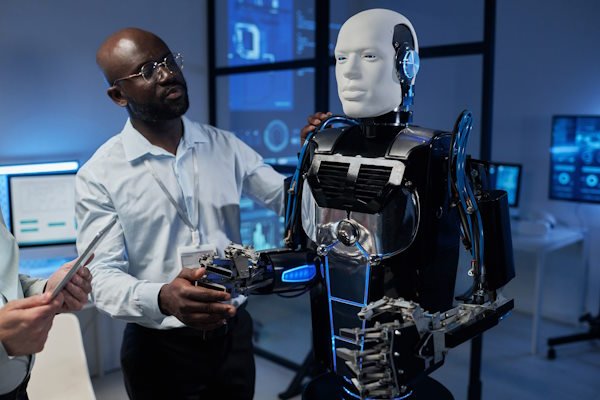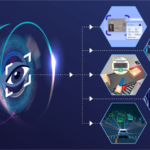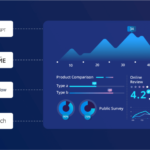
Introduction
As seen in this page, the humanoid robots are slowly take over the world. These are machines that imitate people’s behavior; therefore, they are filled with artificial intelligence. It is possible to say that they can walk, speak, and even demonstrate feelings.
They become smarter on a daily basis due to the progress of AI. Industries like healthcare, retail, and entertainment benefit from them.
The following article discusses how such inventions assist humanoid robots; thus making them even better when it comes to their functionality and interaction with human beings.
What Are Humanoid Robots?
Humanoids are robots, created in the likeness of human beings in terms of their form and operation. They have limbs and sometimes head parts, arms, legs and often they have faces. With this, they are able to perform tasks that are characteristic of human beings.
This makes their design suitable to enable them to easily engage in interaction with people. They are not metallic structures like the typical robot that one can imagine, rather they learn from their environment.
Scientists strive to make them more effective among their given roles in the advancement of science and technology. It makes the learners smarter over time since what is taught uses artificial intelligence.
The Role of AI in Humanoid Robots
Artificial intelligence is the most important component that make up a humanoid robot. They can also reason and make various kinds of decisions, including procedural and practical ones based on the knowledge gathered from the experience.
arto’s decision-making slowly and gradually, and how machine learning algorithms improve their’s decision-making. To make voice recognition possible they use natural language processing technique. AI also allows emotional recognition.
These advancements make interactions smoother. In its absence, humanoid robots would be nothing more than moving structures used for mechanical purposes. AI continuously enhances their capabilities.
Machine Learning in Humanoid Robots
Machine learning means that robots can learn from their surroundings or as it can also be stated as robots acquire new experiences in the process of performing its function or as what is often referred to as the robots gaining knowledge in the process of executing its task.
They take records of the past interaction behavior patterns with a view to enhancing future interaction behaviors. Deep learning models improve the model capability in pattern recognition. These robots mimic the human beings. It assists them to make predictions which are based on positive results or findings.
Over time, they refine their actions. This learning ability makes them more autonomic which helps the company to reduce costs some of which are discussed below. Artificial intelligence enables interaction between human and robots since it allows robots to learn from experience.
Speech Recognition and Communication
One of the important attributes that is widely incorporated in its construction is speech recognition. This makes them capable of transcribing human speech and in a way understanding user’s instructions or inputs. Some other products with similar features as Voice recognition technology include virtual assistants such as Siri and Alexa.
Automatic mechanisms of humanoid robots accept voice information easily. It is okay so far as they can keep talking to people and also respond to questions that may be put to them. AI-driven chatbots enhance communication skills. Due to this, they can be applied in customer care.
In this paper, many advantages of the speech recognition system are marked that denote a high enhancing factor in the user experience of the facilities..
Facial Recognition and Emotional AI
That saves necessary symbols for humanoid robots to use in face and emotions recognising. The facial recognition technology takes into account people’s emotions. Emotional AI is a kind of artificial intelligence that identifies people’s emotions depending on their tone of voice and body movements.
This paper reveals that robots have the ability to respond to human emotions in an appropriate manner. This ability enhances social interactions. The use of autonomous emotion recognition in therapy & counseling is very effective. Some of them are designed to bring consolation or joy to their users.
Another positive aspect is that all of them are associated with high levels of emotional intelligence which makes such characters more realistic.
Humanoid Robots in Healthcare
Several points prove that healthcare is one of the fields that can significantly benefit from the use of humanoid robots. Robots that are implemented into hospitals address some surgeries and patient management. It observes the patient’s condition and helps him/her to remember the need to take or not to take the administered medicine.
Some fend for the elderly and provide for their needs as companion. Robots help to alleviate the burden of work in the health sectors among the health professional. Custom Based on research, there are numerous advantages that have been seen to be accorded by artificial intelligence in completion of medical tasks.
They are used also in physical therapy evaluation and also in physical therapy sessions. Humanoid robots improve healthcare efficiency.
AI in Customer Service and Retail
As it can be seen, the two major fields that have embraced the use of humanoid robots are the retail and the customer service industries. Salespeople are replaced by robots which welcome the customers and attend their queries.
They assist in product recommendations. Some robots handle transactions efficiently. It assists them to know the preferences that the customers have. Their presence enhances customer experience. For the businesses, there are gains in terms of low operation costs. The casual use of robot Humanoid servants is making significant changes in service orientation.
Humanoid Robots in Education
Education is one of the areas that humanoid robots can be applied to and used in. Specifically, the human teachers are supported by the pedagogical robots that are in possession of artificial intelligence. They turn the process more informative and more fun.
Robots help students with disabilities. They provide personalized learning experiences. It helps them to search for academic questions that they require. Humanoid robots encourage student participation. One more benefit you get is that they help to foster a dynamic learning environment. AI enhances education significantly.
Challenges in Developing Humanoid Robots
However, currently, there are several challenges surrounding humanoid robots. It is a known fact that the development of artificial intelligence entails vast costs and time. Ethical concerns about automation arise. Data privacy is another issue. Robots need to be trained once in order to make them perform their given tasks in an efficient manner.
Power consumption is a challenge. AI still struggles with full human-like reasoning. Improvement of AI capabilities have being on ongoing process among the developers. By defeating these difficulties, the future robots will be improved.
The Future of Humanoid Robots
General possibilities of developing humanoid robots is its far senior to the future. It will increase their independence, and as a result, AI will be killed. Future robots will demonstrate emotions of an even higher level.
They shall help humans in numerous fields. It is found that the cognitive ability to enhance the decision-making capabilities will be boosted by natural artificial intelligence. More interactive robots will emerge. Few of the key points that the paper has elucidated in this aspect include the following.
Proactive safety shall be pursued in ethical AI development. The future holds endless possibilities. Warner Bros. Interactive Entertainment Co., Ltd. will release the officially licensed Tomb Raider Game for PlayStation in Japan.
Conclusion
Humanoid robots are transforming industries. In this case, the lifelikeness is greatly due to the involvement of AI. Machine learning, a speech recognition system, and emotional AI improve their efficiency at the same time.
These robots are used in sectors such as health, education and even in the stores sector. There are always barriers as they are but such can be dealt with. It is quite inspiring to note that humanoid robots are in existence. With this, they do not stand still.







